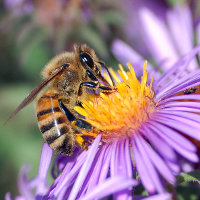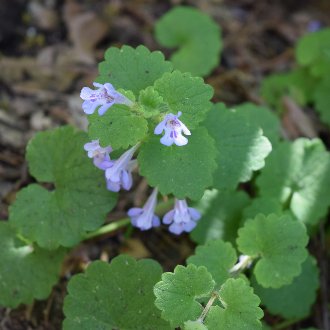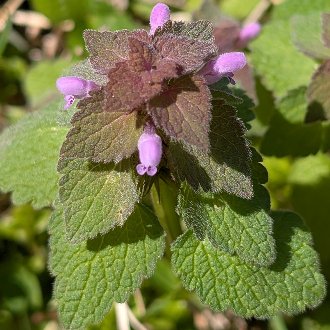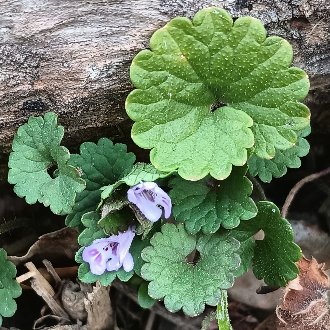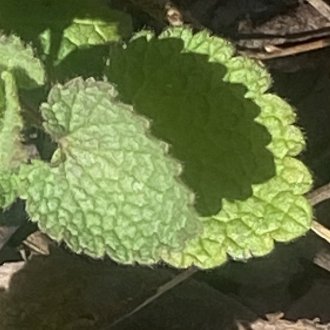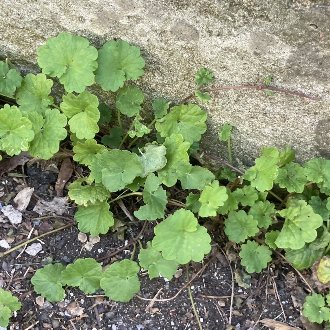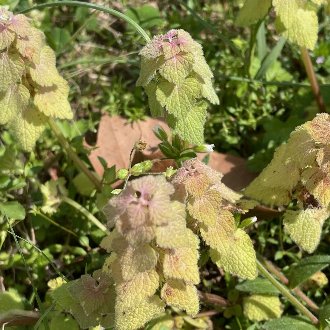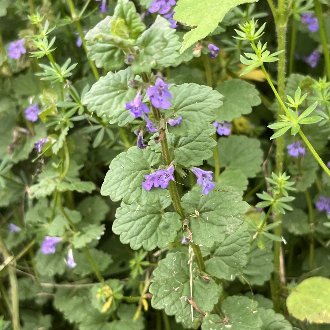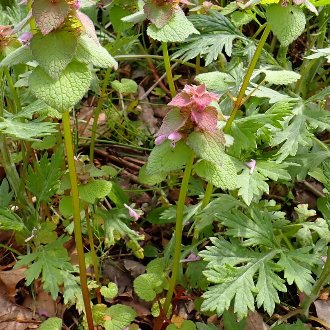Ground Ivy vs Purple Deadnettle
These introduced species are sometimes confused; both are common in gardens and they can grow together in the same habitat. They can be easily distinguished by leaves, flowers, and life cycle. Glechoma hederacea ranges much farther north, can survive in mowed lawns, is present year-round, and is more restricted to partly-sunny exposures, whereas Lamium purpureum inhabits a broader range of lighting conditions, from full sun to areas under a canopy of deciduous trees, and is absent in summer.
Ground Ivy (Glechoma hederacea) | Purple Deadnettle (Lamium purpureum) |
A perennial native to Europe and widely introduced in North America, where it is common in lawns and gardens. | A winter annual native to Eurasia and introduced in North America, usually found on rich, moist sites with disturbed soil. |
Leaves at tip of flowering stems are green, no more reddish-tinged than other leaves. Flowers average a more bluish hue of purple, only rarely a reddish-pink. Corollas open more at their tips. Photo © , CC BY-SA 4.0. | Leaves at tip of flowering stems are tinged with a reddish-purple hue. Flowers average a more reddish hue of pink or purple. Corollas are more bulb-shaped when viewed from above, and smaller at their tips. Photo © Martin Kalfatovic, CC BY 4.0. |
Leaves are more consistently round. Leaf margins are crenate, with more rounded teeth. Leaf texture is coarser, with fewer visible veins and fewer but larger teeth. The two sides of the leaf base often overlap each other or nearly so. Photo © Raven Dandridge, CC BY 4.0. | Leaves are more pointed at the tips. Leaf margins are crenate-to-serrate, with slightly sharper teeth. Leaf texture is finer, with more visible veins and more but smaller teeth. The two sides of the leaf base rarely come close to overlapping. Photo © Sandy Wolkenberg, CC BY 4.0. |
Petioles (stems connecting the leaves to the main stem) are longer and remain long even on leaves directly under flowers. Photo © jjfeiler, CC BY 4.0. | Petioles are shorter, especially on leaves near the tip of the stem, and are often only visible from below on flowering plants. Photo © Sam Gartrell, CC BY 4.0. |
Plants are perennial, remaining green after flowering and producing seed, and are usually still green all summer long, even if growth slows in summer and some dieback occurs in dry years. Photo © bdagley, CC BY 4.0. | Plants are annual, turning yellowish-brown and dying after flowering and producing seed. Plants are usually entirely absent in the heat of summer (July-August). Photo © Tom Scavo, CC BY 4.0. |
At the time of flowering, leaves are equally spaced out along the stem, and leaves lower on the stem are typically retained. Photo © turtless, CC BY 4.0. | At the time of flowering, especially in shaded conditions, leaves are concentrated in the top of the plant and lower portion of stems are elongated and devoid of leaves. Photo © Larry Jensen, CC BY 4.0. |
Additional Notes
Both of these plants are aromatic, with distinctive earthy aromas. They can be easily distinguished by smell, but their fragrances are hard to describe in words. Glechoma hederacea is usually more pungent whereas Lamium purpureum has a more subtle fragrance.The bloom periods of these species overlap so much as to be mostly useless for ID. On average, Glechoma hederacea blooms about a week later than Lamium purpureum, but both species are opportunistic about blooming. Usually, however, the latest-blooming Glechoma hederacea can occur as much as a month after the last Lamium purpureum have finished blooming.
Although both of these species can survive in lawns, they exhibit very different adaptations to doing so. Glechoma hederacea creeps along the ground and retains long-lived leaves along the length of its stem. Mowing will remove only branches that grow upright, and will leave photosynthetic leaves and expose them to more light by removing shading leaves from grass and other plants. Lamium purpureum on the other hand colonizes lawns by completing its whole lifecycle during the off-season, when the lawn is not being mowed. By the time it grows upright and flowers, its lower leaves have already died back. If it were mowed at this point, it would kill the plant, but it usually produces seed before the first mowing, and then the mowing distributes its seeds around, to germinate in the fall and establish again over the winter.
Both of these species are easily confused with henbit deadnettle (Lamium amplexicaule), and all three can occur together. Henbit's life cycle and adaptations are more like that of Lamium purpureum, to which it is more closely related.
References & External Resources
These short lists show only links helpful for ID. For a complete list of references and resources also covering other aspects of ecology, visit the links section of the full article on each plant, which is the first entry here.

